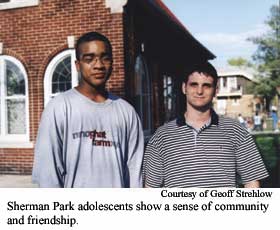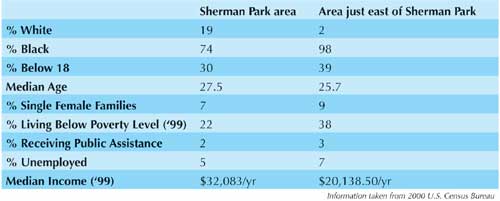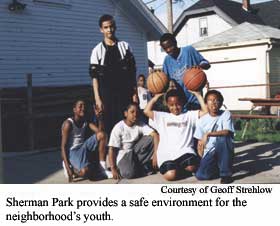By Lauren O'Connell and Lindsay
Renick Mayer
Step through the fire engine red doors, and
the color inside pops. Bright red chairs sit beneath mustard yellow
tables
that
complement
blue and yellow walls. Though bold, the wall color is almost indiscernible
behind the eclectic collage of items that hang there, all radiating
neighborhood pride - framed awards given for efforts to strengthen
community, pictures of nearby houses, children’s artwork, a bulletin
board full of local business cards.
 But
the palette of diversity at the Sherman Perk, a community coffee shop,
extends far beyond the décor. Behind the counter, two young women,
one black and one white, talk and laugh with each other. Three school-age
boys run excitedly around the café, yarmulkes atop their heads.
Straight ahead, a young black couple plays chess on an oversized board,
while an elderly white man sips coffee and eats an egg salad sandwich
with his middle-aged son. But
the palette of diversity at the Sherman Perk, a community coffee shop,
extends far beyond the décor. Behind the counter, two young women,
one black and one white, talk and laugh with each other. Three school-age
boys run excitedly around the café, yarmulkes atop their heads.
Straight ahead, a young black couple plays chess on an oversized board,
while an elderly white man sips coffee and eats an egg salad sandwich
with his middle-aged son.
Nobody seems alarmed by the varying skin tone, age and religious attire
because this scene is the norm at the Sherman Perk and almost everywhere
else in the community of Sherman Park. And yet, Sherman Park is nestled
in urban Milwaukee, an area that, according to the 2000 Census, is the
second-most-segregated metropolitan city in the country. And like the
bold ambiance of the Sherman Perk, the racial integration of the community
makes visitors feel like they’ve stepped into a different world.
Exit the Sherman Perk and talk to the citizens who live within the boundaries
of W. Capitol Drive, W. North Ave., N. 30th and N. 60th streets. Only
then does it start to become clear how a community of 38,000 has managed
to make impressive steps toward integration for 30 years in a city with
a reputation for intractable segregation.
In contrast to much of Milwaukee, Sherman Park boasts a reputation of
diversity that is also reflected in the very census data that displays
apparent segregation in nearby areas. While the 2000 Census shows Sherman
Park with about 75 percent black population and nearly 20 percent white,
the Census tracts to the east of Sherman Park toward Johnson’s
Park are 96 percent black and about 2 percent white.
According to Steve O’Connell, executive director of the Sherman
Park Community Association (SPCA) and a resident of 17 years, about 118
Orthodox Jewish families call the area home. O’Connell also estimates
a homosexual community of about 2 percent and says that interracial families
are common. He explains that his own block is truly integrated - about
50 percent white and 50 percent black.
Sherman Park residents admit that they don’t understand the extreme
segregation in the rest of Milwaukee, but they attribute their own progress
to many different factors including the area’s history, economic
differences, housing stock and strong community involvement.

History
Sherman Park has had a history of diversity and community activism since
1970, when a group of seven white couples of varying ages, economic and
religious backgrounds
united to form SPCA.
Lila Kelly, an SPCA founder, had already seen how quickly a community could segregate.
According to Kelly, the association attempted to avoid problems noticed in other
communities such as Atkinson-Teutonia, where white residents were fleeing when
blacks moved in. “We wanted to promote a racially integrated, economically
diverse community in the heart of the city,” Kelly says. At its start,
however, Sherman Park only had one black family in the entire community.
Since then, diversity has increased significantly and the Kellys still live in
the community after 35 years.
The Kellys and the six other founding couples decided that Sherman Park would
pride itself on being an accepting and community-oriented place to live. They
originally addressed the topics of housing, schools and the expansion of a major
expressway.
Throughout their history, Sherman Park residents have fought for integration
in schools and against redlining and other practices that undermine fair housing.
They have made a point to work toward diversity.
According to SPCA volunteer and 12-year resident of Sherman Park Geoff Grohowski,
tradition plays a big role in the area’s current demographics. “By
tradition we’ve created an atmosphere where people feel free to bring their
lives with them without feeling like they’re going to stick out like a
sore thumb,” Grohowski says.
Many residents cite this longstanding tradition of multiculturalism as one of
the main attractions of living in the area. Kurtez Ellis, a high school student
who has lived in Sherman Park for five years, remarks on one of the advantages
of diversity. “You get a feel for the different cultures and the different
ways cultures in society are run and how they handle different situations,” Ellis
says.
 Other
neighborhoods in the city have been segregated as long as residents
can remember. Milwaukee has a history of segregation that wasn’t
always based on skin color. European immigrants once lived in separate
parts of Milwaukee based upon their nationality. Italians dominated
the 3rd Ward on the near south side while Germans held the East side
and Polish the south side. As the black population began to increase
in the 1950s and 1960s, the face of segregation changed, clustering
together almost all of the 90,000 blacks into Milwaukee’s inner
city. The blacks there called it home, but the whites, who often fled
to the suburbs, usually disdainfully called it “the core.” Other
neighborhoods in the city have been segregated as long as residents
can remember. Milwaukee has a history of segregation that wasn’t
always based on skin color. European immigrants once lived in separate
parts of Milwaukee based upon their nationality. Italians dominated
the 3rd Ward on the near south side while Germans held the East side
and Polish the south side. As the black population began to increase
in the 1950s and 1960s, the face of segregation changed, clustering
together almost all of the 90,000 blacks into Milwaukee’s inner
city. The blacks there called it home, but the whites, who often fled
to the suburbs, usually disdainfully called it “the core.”
Today,
the Census cites Milwaukee’s dissimilarity index at 82.2
percent, meaning that 82.2 percent of blacks would need to move from
the area to have
100 percent integration. It also states that almost 96 percent of blacks in the
Milwaukee area live within the city limits and slightly less than 5 percent live
in the suburbs. Although the ranking and the census analysis methods met with
criticism from the Employment Training Institute at the UW-Milwaukee, the ETI
still ranked Milwaukee 43 out of the 100 most integrated metropolitan areas,
using a block-by-block measurement technique.
As for Milwaukee as a whole, Kelly cannot understand why it is still so segregated. “I
honestly don’t know,” she says. “It was like that when we came.
It’s distressing. I just plain don’t understand it.”
Economics
Some Sherman Park residents speculate that their success results from economic
differences between their community and some other areas of Milwaukee. “Economically,
we have a strong middle-class component,” O’Connell says. “A
lot of times segregation is economic-based. People forget about that.”
The difference in white and black income for the Milwaukee Metropolitan Area,
according to the 2000 Census, sits at nearly two to one, meaning that blacks
in Milwaukee, on average, make about half as much as whites.
This income disparity often affects the location in which Milwaukeeans choose
to settle, resulting in the lack of a strong middle-class in many of the suburbs
and in much of the inner city.
The average income of a community can also determine how safe it is perceived
to be, which can attract or scare off potential residents. According to Shellee
Lubus, community liaison officer for the 7th Police District and an eight-year
Sherman Park resident, crime in the area is largely property-based and rarely
threatens personal safety. It is also rarely tied to issues between races. The
SPCA maintains a strong relationship with the police to ensure crime levels stay
down.
“Things don’t always go smoothly, but at least we have an association
to
work with to work out problems,” Lubus says. “We’re all willing
to come to the table.”
Although economics play a role in Sherman Park’s story, many other factors
help explain how the community manages diversity other neighborhoods cannot seem
to achieve.
Housing
 Sherman
Park residents describe the housing in the area as impressive, affordable
and stylistically diverse. Some residents moved to the area specifically
because of the attractiveness of the houses. Oretha Harris, an SPCA
volunteer and 10-year resident of the neighborhood, confesses that the
houses, not the diversity, brought her to Sherman Park. “Honestly,
it was the homes,” she says. “Ever since I was a child I
dreamed of living in one of the Lannon stone houses. The neighborhood
is just beautiful.” Sherman
Park residents describe the housing in the area as impressive, affordable
and stylistically diverse. Some residents moved to the area specifically
because of the attractiveness of the houses. Oretha Harris, an SPCA
volunteer and 10-year resident of the neighborhood, confesses that the
houses, not the diversity, brought her to Sherman Park. “Honestly,
it was the homes,” she says. “Ever since I was a child I
dreamed of living in one of the Lannon stone houses. The neighborhood
is just beautiful.”
According to O’Connell, property values in Sherman Park have risen in recent
years, while some city neighborhoods have seen value fall.
Perhaps the rise can be attributed to the eclectic mix of homes in the community.
Bob Olin, owner of the Sherman Perk and a 22-year resident, describes the variety
that makes living in a Sherman Park home a wonderful option. “The housing
stock is extremely desirable,” Olin says. “There’s a mix of
housing from the ‘20s, ‘30s and ‘40s. And because it’s
city property, it’s much more affordable than the suburbs.”
Experts often cite the lack of affordable housing in the suburbs and the difficulty
people of color face when applying for insurance and loans as primary reasons
for segregation. According to the Milwaukee Metropolitan Fair Housing Council
(MMFHC),
the Realtor Code of Ethics in Milwaukee between 1924 and 1950 went so far as
to mandate that “a realtor should never be instrumental in introducing
into neighborhoods members of any race, nationality, or individuals whose presence
will clearly be detrimental to property values.”
Although laws no longer exist to keep blacks isolated in the city as they once
did, other loan practices may have taken their place. Some community watchdogs
suspect that practices such as redlining still occur in Milwaukee, as in many
other urban areas. Redlining describes the act of tracing out certain areas,
those that are seen as poverty-stricken or high-risk, and denying property insurance
to anyone living in those areas. This practice may account for the overwhelming
statistics on loan denial rates for blacks. According to an analysis done by
Association of Community Organizations for Reform Now (ACORN), blacks in Milwaukee
were more than five times more likely to be denied conventional mortgage loans
than whites in 2003.
Because Sherman Park offers affordable housing, lower-income families have an
easier time settling there. SPCA helps such families by being a watchdog against
discriminatory housing practices that might threaten the community’s integration.
In addition, residents take pride in the appearance of the community. According
to Kelly, every spring a group will drive through the blocks looking for houses
that may need painting and garbage that has lingered too long in the alleys.
SPCA encourages residents to turn on porch lights at night and to pick up litter. “These
things contribute to the overall ambiance of the neighborhood,” Kelly says.
Community Involvement
More than anything else, Sherman Park residents attribute their diversity to
strong community involvement and programs spearheaded by SPCA. According to O’Connell,
all 15 SPCA board members live in the community, and the association has appointed
volunteers called “block captains” to take care of resident concerns
on a block-by-block basis. The board members and SPCA volunteers represent the
full spectrum of ethnicities in the neighborhood and address pertinent community
issues.
James Hiller, SPCA volunteer and a 19-year resident of Sherman Park, finds
the combined
efforts of different community members a matter of necessity. “I think
there are interests and challenges which are common to people in families irrespective
of race, gender, nationality and so on,” he says.
Because of this, SPCA deals with other societal issues like quality of education,
care for the elderly, the provision of resources for families, pollution and
unfair business practices. The association also hosts festivals throughout the
year - literal celebrations of diversity.
This tight-knit community produces residents who work hard to attain
the quality of life they want. “When you develop roots in the community,
you develop a sense of responsibility, and this translates to action,” Hiller
says.
Those roots lead many Sherman Park residents to remain in the area for decades. “I
think people have a hard time leaving a place where people really care about
community,” Harris says. “I used to live in the suburbs, in Franklin,
and I could never move back.”
Sherman Park’s progress gives Ellis hope for the future of the greater
Milwaukee area. Although he is only 15, Ellis already takes an active role in
the community as an SPCA volunteer. “I think that if you find out how the
different races came together to live in peace, that result will lead to the
coming together of one giant community, hopefully making Milwaukee a community
that is unified and not segregated,” Ellis says.
Perhaps unique obstacles stand in the way for other, more segregated parts of
the city. But through a combination of efforts, Sherman Park residents work together
despite their racial and religious differences and strive to make the community
even more integrated.
“I don’t know what the real ingredient is,” Hiller says. “But
there’s some magic in Sherman Park.”
For more information, visit the following sites:
UWM's
Employment and Training Institute: Examines a study conducted
on racial integration in urban America. This study is known for "exploding
the myth" of hypersegregation in Milwaukee.
City of Milwaukee Department of City
Development: This site provides
links to census data as well as housing resources. |






 But
the palette of diversity at the Sherman Perk, a community coffee shop,
extends far beyond the décor. Behind the counter, two young women,
one black and one white, talk and laugh with each other. Three school-age
boys run excitedly around the café, yarmulkes atop their heads.
Straight ahead, a young black couple plays chess on an oversized board,
while an elderly white man sips coffee and eats an egg salad sandwich
with his middle-aged son.
But
the palette of diversity at the Sherman Perk, a community coffee shop,
extends far beyond the décor. Behind the counter, two young women,
one black and one white, talk and laugh with each other. Three school-age
boys run excitedly around the café, yarmulkes atop their heads.
Straight ahead, a young black couple plays chess on an oversized board,
while an elderly white man sips coffee and eats an egg salad sandwich
with his middle-aged son. 
 Other
neighborhoods in the city have been segregated as long as residents
can remember. Milwaukee has a history of segregation that wasn’t
always based on skin color. European immigrants once lived in separate
parts of Milwaukee based upon their nationality. Italians dominated
the 3rd Ward on the near south side while Germans held the East side
and Polish the south side. As the black population began to increase
in the 1950s and 1960s, the face of segregation changed, clustering
together almost all of the 90,000 blacks into Milwaukee’s inner
city. The blacks there called it home, but the whites, who often fled
to the suburbs, usually disdainfully called it “the core.”
Other
neighborhoods in the city have been segregated as long as residents
can remember. Milwaukee has a history of segregation that wasn’t
always based on skin color. European immigrants once lived in separate
parts of Milwaukee based upon their nationality. Italians dominated
the 3rd Ward on the near south side while Germans held the East side
and Polish the south side. As the black population began to increase
in the 1950s and 1960s, the face of segregation changed, clustering
together almost all of the 90,000 blacks into Milwaukee’s inner
city. The blacks there called it home, but the whites, who often fled
to the suburbs, usually disdainfully called it “the core.”
 Sherman
Park residents describe the housing in the area as impressive, affordable
and stylistically diverse. Some residents moved to the area specifically
because of the attractiveness of the houses. Oretha Harris, an SPCA
volunteer and 10-year resident of the neighborhood, confesses that the
houses, not the diversity, brought her to Sherman Park. “Honestly,
it was the homes,” she says. “Ever since I was a child I
dreamed of living in one of the Lannon stone houses. The neighborhood
is just beautiful.”
Sherman
Park residents describe the housing in the area as impressive, affordable
and stylistically diverse. Some residents moved to the area specifically
because of the attractiveness of the houses. Oretha Harris, an SPCA
volunteer and 10-year resident of the neighborhood, confesses that the
houses, not the diversity, brought her to Sherman Park. “Honestly,
it was the homes,” she says. “Ever since I was a child I
dreamed of living in one of the Lannon stone houses. The neighborhood
is just beautiful.”